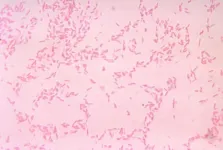(Press-News.org) RIVERSIDE, Calif. -- When participating in research studies, moderately anxious or highly anxious children from minoritized groups are likely to be hypervigilant to threat, further compounding the effects of their general state of anxiety, a research study led by a University of California, Riverside, psychologist reports.
The study, which involved the participation of 46 Inland Southern California preadolescent Latina girls (8–13 years), has implications also for children from families with low socioeconomic status.
“Psychological research is often conducted in white, educated, and affluent communities,” said Kalina Michalska, an associate professor of psychology, who led the research team. “People from minoritized groups or people with low income and/or limited access to education are often not exposed to scientific research, and have historically been exploited by science, which contributes to their discomfort or legitimate mistrust.”
In the study, the girls first completed a laboratory testing session during which they and their caregivers reported on family demographics as well as the girls’ behavior, anxiety, and other mental health outcome measures. The girls then completed an emotion processing task while in an MRI scanner. They viewed images of fearful and happy faces projected into the scanner bore while the researchers measured their brain responses.
“Trait anxiety” is a constant state of anxiety. “State anxiety” is defined as a momentary feeling of anxiety, the kind one might experience going to the doctor’s office to learn the results of tests or when giving a public lecture.
The researchers found that among girls with average or high levels of trait anxiety, their state anxiety before being MRI-scanned was associated with greater brain responses — specifically, an increased amygdala-hippocampal response — to fearful faces (threat stimuli) versus happy faces. This means a generally anxious participant experienced high levels of momentary anxiety when situated in a distressing environment, such as the MRI scanner.
“Undergoing an MRI scan is anxiety-inducing not just for children but also, more generally, for people unfamiliar with the scanning environment,” Michalska said.
In the study, which appears in the open access journal BMC Psychiatry, girls who rated their families as having a lower community standing tended to have elevated pre-scan state anxiety, suggesting that factors such as social status can influence children’s reactions to the research environment.
Michalska, an expert on pediatric anxiety disorders, urges neuroimaging researchers to control for state anxiety and help participants from all backgrounds feel as comfortable as possible during testing sessions.
“Without accounting for state anxiety, data from experiments such as ours could be misattributed to temperamental, environmental, or cultural factors rather than apprehension of the research environment,” she said.
According to Michalska, when children who are at risk for anxiety disorder (trait anxiety) are anxious “in the moment” (state anxiety), the differences in brain activity are due to the momentary anxiety, not the anxiety disorder.
“When interpreting the data, it is important not to misattribute the findings to an anxiety disorder or to a whole community when it is only momentary and situational anxiety,” she said. “Brain responses in experiments like ours need to be attributed not necessarily to the fact that the participants are, say, Latina, but to their historical experiences with science. Our participants had high anxiety because they were entering a space that has historically been hostile to them.”
Michalska is hopeful the team’s findings can lead to new conversations about mental health.
“Doctors can change the way they think about patients’ mental health and teachers can think differently about the mental health of their students,” she said. “Our data show that socioeconomic status can play a significant role in patients’ and students’ anxiety and suggest that the scanning environment may be particularly anxiety-inducing for participants who feel marginalized relative to other members of society.”
Next, the researchers plan on measuring social experiences, such as parents’ experiences of ethnic racial discrimination and children’s experiences of the same. The researchers also plan to measure children’s vicarious experiences resulting from watching their parents’ encounters with ethnic racial discrimination.
Michalska was joined in the research by her former graduate student and first author of the paper Dana E. Díaz, now at Columbia University Irving Medical Center in New York, and Wan-Ling Tseng of Yale University in Connecticut.
The research was funded by a grant from the Hellman Fellows Program and a National Institute of Health subaward from the UCR Center for Health Disparities Research.
The title of the research paper is “Pre-scan state anxiety is associated with greater right amygdala-hippocampal response to fearful versus happy faces among trait-anxious Latina girls.”
The University of California, Riverside is a doctoral research university, a living laboratory for groundbreaking exploration of issues critical to Inland Southern California, the state and communities around the world. Reflecting California's diverse culture, UCR's enrollment is more than 26,000 students. The campus opened a medical school in 2013 and has reached the heart of the Coachella Valley by way of the UCR Palm Desert Center. The campus has an annual impact of more than $2.7 billion on the U.S. economy. To learn more, visit www.ucr.edu.
END
Minoritized groups face high anxiety when taking part in research experiments
Preadolescent girls used an MRI scanner in UC Riverside-led study
2024-03-01
ELSE PRESS RELEASES FROM THIS DATE:
Orcas demonstrating they no longer need to hunt in packs to take down the great white shark
2024-03-01
An orca (killer whale) has been observed, for the first-ever time, individually consuming a great white shark – and within just two minutes.
“The astonishing predation, off the coast of Mossel Bay, South Africa, represents unprecedented behavior underscoring the exceptional proficiency of the killer whale”, remarks Dr. Alison Towner from Rhodes University, who led an international research team into the discovery.
Their findings are published today in the peer-reviewed African Journal of Marine Science.
The groundbreaking insight is the latest from Dr. Towner and the team, who, in 2022 in the same journal, ...
Scientists discover a novel vehicle for antibiotic resistance
2024-03-01
By David L. Chandler
WOODS HOLE, Mass. -- Antibiotic resistance is a significant and growing medical problem worldwide. Researchers at the Marine Biological Laboratory (MBL) and collaborators have found a novel genetic arrangement that may help a common bacterium in the human gut, Bacteroides fragilis, protect itself from tetracycline, a widely used antibiotic.
While these findings will not lead directly to new ways of combating tetracycline-resistant bacteria, the researchers have discovered previously unseen genetic arrangements that confer antibiotic resistance. Such understanding might help in developing new ways to limit the spread of antibiotic resistance genes, through genetic ...
Large-scale study explores link between smoking and DNA changes across six racial and ethnic groups
2024-03-01
Smoking changes the way genes are expressed, which later contributes to the development of lung cancer and other smoking-related illnesses. But the link between epigenetics (the study of mechanisms that impact gene expression) and smoking is not fully understood, especially in terms of differences across racial and ethnic groups.
“We know that smoking affects people differently based on their race and ethnicity, but identifying epigenetic signatures of smoking would help us better predict risk for smoking-related diseases,” said Brian Huang, PhD, an assistant professor in the department of population ...
EU funding for outstanding early-career researcher Pieter Gunnink
2024-03-01
Dr. Pieter Gunnink from the Institute of Physics at Johannes Gutenberg University Mainz (JGU) has been awarded a EUR 190,000 Marie Skłodowska-Curie Postdoctoral Fellowship by the European Commission. The grant is an individual award for Gunnink's outstanding achievements in the field of spintronics and provides financial support for his research over a period of 24 months.
Modern information processing relies heavily on the use of electrical current, the transport of which requires large amounts of energy. The field of ...
Associate Professor Ron Korstanje, Ph.D., of The Jackson Laboratory named Evnin Family Chair
2024-03-01
Associate Professor Ron Korstanje, Ph.D., has been named the Evnin Family Chair at The Jackson Laboratory. An expert in the genetics of kidney function and disease, Korstanje’s appointment marks a new chapter in his 20 years of service to JAX’s mission.
“Ron’s exceptional contributions to JAX have advanced research discoveries and nurtured generations of future scientists,” said President and CEO Lon Cardon, Ph.D., FMedSci. “His appointment as the Evnin Family ...
Researchers create coating solution for safer food storage
2024-03-01
In a collaborative effort to improve the food industry, Dr. Mustafa Akbulut, professor of chemical engineering, and Dr. Luis Cisneros-Zevallos, professor of horticultural science, have developed a two-step coating solution for galvanized steel that is more hygienic and reduces the risk of corrosion.
Galvanized steel containers and surfaces are used for harvested produce because of their durability, strength and lower cost compared to stainless steel. However, bacteria residing in storage containers can cause corrosion.
The ...
An overgrowth of nerve cells appears to cause lingering symptoms after recurrent UTIs
2024-03-01
DURHAM, N.C. – A perplexing problem for people with recurring urinary tract infections (UTIs) is persistent pain, even after antibiotics have successfully cleared the bacteria.
Now Duke Health researchers have identified the likely cause - an overgrowth of nerve cells in the bladder.
The finding, appearing March 1 in the journal Science Immunology, provides a potential new approach to managing symptoms of recurring UTIs that would more effectively target the problem and reduce unnecessary antibiotic usage.
“Urinary tract infections account for almost 25% of infections in women,” said senior author Soman Abraham, Ph.D., professor in the departments ...
New findings on the immune system
2024-03-01
T follicular helper cells (Tfh) are essential for strong antibody-mediated reactions of our immune system during infections and vaccinations. However, if they get out of control, this can cause diseases such as autoimmunity, allergies or cancer. Researchers from the University Hospital Bonn (UKB) and the Cluster of Excellence ImmunoSensation2 at the University of Bonn investigated the underlying mechanisms of Tfh cell development in a mouse model and thus decoded their internal networking. They hope that this will lead to new strategies for the development of highly effective vaccines and new therapies to combat various diseases. The results have ...
Most smokers in England wrongly believe vaping is at least as harmful as smoking
2024-03-01
More than half of smokers in England wrongly believe that vaping is more harmful or as harmful as smoking, according to a new study led by UCL (University College London) researchers.
The study, published in the journal JAMA Network Open and funded by Cancer Research UK, looked at survey responses from 28,393 smokers in England between 2014 and 2023.
The research team found that public perceptions of e-cigarettes had worsened considerably over the past decade, with an overall increase in the perceived harm of e-cigarettes since 2021, coinciding with a sharp rise in vaping among young ...
New antibodies target “dark side” of influenza virus protein
2024-03-01
WHAT:
Researchers at the National Institutes of Health have identified antibodies targeting a hard-to-spot region of the influenza virus, shedding light on the relatively unexplored “dark side” of the neuraminidase (NA) protein head. The antibodies target a region of the NA protein that is common among many influenza viruses, including H3N2 subtype viruses, and could be a new target for countermeasures. The research, led by scientists at the National Institute of Allergy and Infectious Diseases’ Vaccine Research Center, part of NIH, was published today in Immunity.
Influenza, or flu, sickens millions ...
LAST 30 PRESS RELEASES:
Making lighter work of calculating fluid and heat flow
Normalizing blood sugar can halve heart attack risk
Lowering blood sugar cuts heart attack risk in people with prediabetes
Study links genetic variants to risk of blinding eye disease in premature infants
Non-opioid ‘pain sponge’ therapy halts cartilage degeneration and relieves chronic pain
AI can pick up cultural values by mimicking how kids learn
China’s ecological redlines offer fast track to 30 x 30 global conservation goal
Invisible indoor threats: emerging household contaminants and their growing risks to human health
Adding antibody treatment to chemo boosts outcomes for children with rare cancer
Germline pathogenic variants among women without a history of breast cancer
Tanning beds triple melanoma risk, potentially causing broad DNA damage
Unique bond identified as key to viral infection speed
Indoor tanning makes youthful skin much older on a genetic level
Mouse model sheds new light on the causes and potential solutions to human GI problems linked to muscular dystrophy
The Journal of Nuclear Medicine ahead-of-print tip sheet: December 12, 2025
Smarter tools for peering into the microscopic world
Applications open for funding to conduct research in the Kinsey Institute archives
Global measure underestimates the severity of food insecurity
Child survivors of critical illness are missing out on timely follow up care
Risk-based vs annual breast cancer screening / the WISDOM randomized clinical trial
University of Toronto launches Electric Vehicle Innovation Ontario to accelerate advanced EV technologies and build Canada’s innovation advantage
Early relapse predicts poor outcomes in aggressive blood cancer
American College of Lifestyle Medicine applauds two CMS models aligned with lifestyle medicine practice and reimbursement
Clinical trial finds cannabis use not a barrier to quitting nicotine vaping
Supplemental nutrition assistance program policies and food insecurity
Switching immune cells to “night mode” could limit damage after a heart attack, study suggests
URI-based Global RIghts Project report spotlights continued troubling trends in worldwide inhumane treatment
Neutrophils are less aggressive at night, explaining why nighttime heart attacks cause less damage than daytime events
Menopausal hormone therapy may not pose breast cancer risk for women with BRCA mutations
Mobile health tool may improve quality of life for adolescent and young adult breast cancer survivors
[Press-News.org] Minoritized groups face high anxiety when taking part in research experimentsPreadolescent girls used an MRI scanner in UC Riverside-led study





